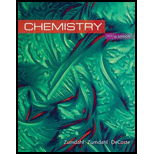
(a)
Interpretation: The ion or molecule, having iodine as the central atom, that is isoelectronic with each of the given compounds is to be stated.
Concept introduction: Two compounds are said to be isoelectronic if they contains same number of valence electrons.
Total number of valence electrons in a compound is equal to the sum of valence electrons present in each atom of that compound.
To determine: The ion or molecule, having iodine as the central atom, that is isoelectronic with each of the given compounds.
(a)
Explanation of Solution
The compound
The molecule xenon tetroxide
An ion
Since
(b)
Interpretation: The ion or molecule, having iodine as the central atom, that is isoelectronic with each of the given compounds is to be stated.
Concept introduction: Two compounds are said to be isoelectronic if they contains same number of valence electrons.
Total number of valence electrons in a compound is equal to the sum of valence electrons present in each atom of that compound.
To determine: The ion or molecule, having iodine as the central atom, that is isoelectronic with each of the given compounds.
(b)
Explanation of Solution
The compound
The molecule xenon tetroxide
An ion
Since
(c)
Interpretation: The ion or molecule, having iodine as the central atom, that is isoelectronic with each of the given compounds is to be stated.
Concept introduction: Two compounds are said to be isoelectronic if they contains same number of valence electrons.
Total number of valence electrons in a compound is equal to the sum of valence electrons present in each atom of that compound.
To determine: The ion or molecule, having iodine as the central atom, that is isoelectronic with each of the given compounds.
(c)
Explanation of Solution
The compound
The molecule xenon difluoride
An ion
Since
(d)
Interpretation: The ion or molecule, having iodine as the central atom, that is isoelectronic with each of the given compounds is to be stated.
Concept introduction: Two compounds are said to be isoelectronic if they contains same number of valence electrons.
Total number of valence electrons in a compound is equal to the sum of valence electrons present in each atom of that compound.
To determine: An ion or molecule in which iodine is the central atom and that is isoelectronic with xenon tetrafluoride.
(d)
Explanation of Solution
The compound
The molecule xenon tetrafluoride
An ion
Since
(e)
Interpretation: The ion or molecule, having iodine as the central atom, that is isoelectronic with each of the given compounds is to be stated.
Concept introduction: Two compounds are said to be isoelectronic if they contains same number of valence electrons.
Total number of valence electrons in a compound is equal to the sum of valence electrons present in each atom of that compound.
To determine: An ion or molecule in which iodine is the central atom and that is isoelectronic with xenon hexafluoride.
(e)
Explanation of Solution
The compound
The molecule xenon hexafluoride
An ion
Since
Want to see more full solutions like this?
Chapter 20 Solutions
Chemistry
- a) Write the chemical name and chemical formula of a compound formed between an atom of group 1 A, period 4 with sulphate ion. b) Explain the type of chemical reaction, which is the opposite of the synthesis reaction and mention two examples of chemical reactions. c) Explain the chemical bond formation with Lewis dot and cross structure that occurs in between X and Y. The X has mass number= 20 and number of neutrons= 20 and Y has mass number =31 and number of electrons= 15. (Mention the type of chemical bond).arrow_forwardWhat is Inorganic Chemistry? What are Hydride Compounds? Sketch the periodic table and label the areas containing elements that give rise to Ionic, Covalent and Metallic hydrides. Identify on the periodic table the area where a hydride gap occurs. What is an Isotope? Hydrogen gas can be prepared in the Laboratory. Explain the following: Why is the gas collected by the downward displacement of water. Why hydrogen gas is not collected by air? Hydrogen has only one proton, but its Ionization energy is much greater than that of Lithium, which has three protons. Explain. Helium has an atomic number of 2 and a mass number of 4. This means that a neutral helium atom is made up of? Choose one answer from below: 4 neutrons, 2 protons and 2 electrons 4 neutrons, 4 protons and 2 electrons 2 neutrons, 4 protons and 2 electrons 2 neutrons, 2 protons and 2 electrons State two Physical Properties of Helium and give three uses of the Helium Gas. Why are the…arrow_forwardDefine the bonding that exists in metals and how this model explains some of the unique physical properties of metals. What are metal alloys? Identify the two main types of alloys, and describe how their structures differ. Give several examples of each type of alloy.arrow_forward
 ChemistryChemistryISBN:9781305957404Author:Steven S. Zumdahl, Susan A. Zumdahl, Donald J. DeCostePublisher:Cengage Learning
ChemistryChemistryISBN:9781305957404Author:Steven S. Zumdahl, Susan A. Zumdahl, Donald J. DeCostePublisher:Cengage Learning
 Chemistry: An Atoms First ApproachChemistryISBN:9781305079243Author:Steven S. Zumdahl, Susan A. ZumdahlPublisher:Cengage Learning
Chemistry: An Atoms First ApproachChemistryISBN:9781305079243Author:Steven S. Zumdahl, Susan A. ZumdahlPublisher:Cengage Learning World of Chemistry, 3rd editionChemistryISBN:9781133109655Author:Steven S. Zumdahl, Susan L. Zumdahl, Donald J. DeCostePublisher:Brooks / Cole / Cengage Learning
World of Chemistry, 3rd editionChemistryISBN:9781133109655Author:Steven S. Zumdahl, Susan L. Zumdahl, Donald J. DeCostePublisher:Brooks / Cole / Cengage Learning Chemistry: The Molecular ScienceChemistryISBN:9781285199047Author:John W. Moore, Conrad L. StanitskiPublisher:Cengage Learning
Chemistry: The Molecular ScienceChemistryISBN:9781285199047Author:John W. Moore, Conrad L. StanitskiPublisher:Cengage Learning General Chemistry - Standalone book (MindTap Cour...ChemistryISBN:9781305580343Author:Steven D. Gammon, Ebbing, Darrell Ebbing, Steven D., Darrell; Gammon, Darrell Ebbing; Steven D. Gammon, Darrell D.; Gammon, Ebbing; Steven D. Gammon; DarrellPublisher:Cengage Learning
General Chemistry - Standalone book (MindTap Cour...ChemistryISBN:9781305580343Author:Steven D. Gammon, Ebbing, Darrell Ebbing, Steven D., Darrell; Gammon, Darrell Ebbing; Steven D. Gammon, Darrell D.; Gammon, Ebbing; Steven D. Gammon; DarrellPublisher:Cengage Learning





